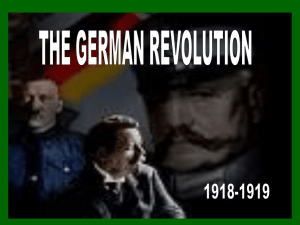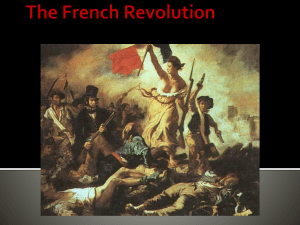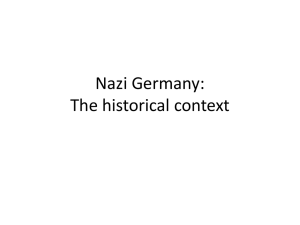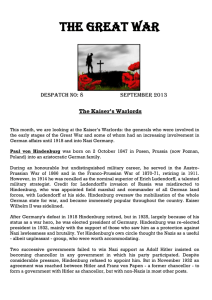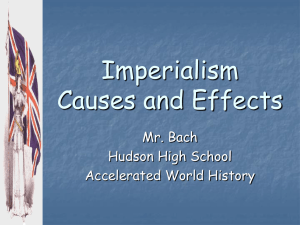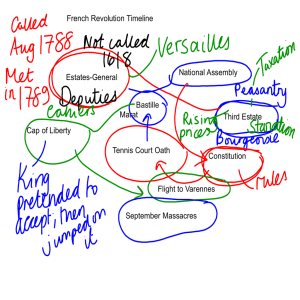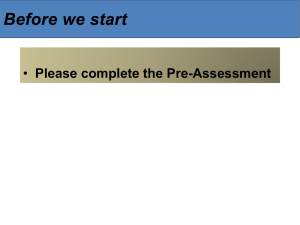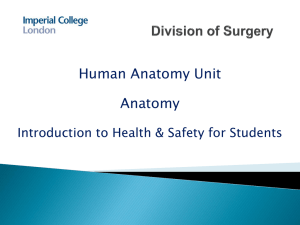The Collapse of Imperial Germany
advertisement
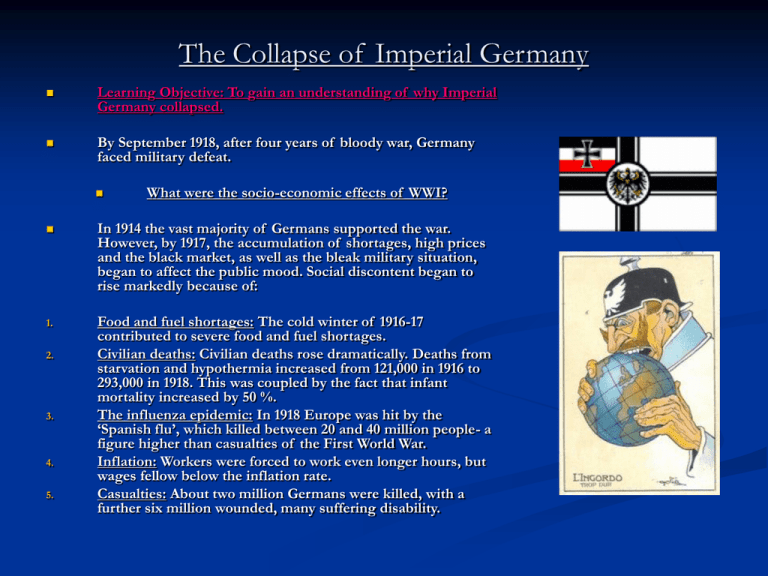
The Collapse of Imperial Germany Learning Objective: To gain an understanding of why Imperial Germany collapsed. By September 1918, after four years of bloody war, Germany faced military defeat. What were the socio-economic effects of WWI? In 1914 the vast majority of Germans supported the war. However, by 1917, the accumulation of shortages, high prices and the black market, as well as the bleak military situation, began to affect the public mood. Social discontent began to rise markedly because of: 1. Food and fuel shortages: The cold winter of 1916-17 contributed to severe food and fuel shortages. Civilian deaths: Civilian deaths rose dramatically. Deaths from starvation and hypothermia increased from 121,000 in 1916 to 293,000 in 1918. This was coupled by the fact that infant mortality increased by 50 %. The influenza epidemic: In 1918 Europe was hit by the ‘Spanish flu’, which killed between 20 and 40 million people- a figure higher than casualties of the First World War. Inflation: Workers were forced to work even longer hours, but wages fellow below the inflation rate. Casualties: About two million Germans were killed, with a further six million wounded, many suffering disability. 2. 3. 4. 5. Social discontent, therefore, grew markedly in the final two years of the war. Opposition began to grow against the political leaders. Faced with the worsening situation on the domestic front and the likelihood of defeat on the Western Front, the military leaders- Generals Ludendorff and Hindenburg, recognised the seriousness of Germany’s position- and decided to seek peace with the Allies. Ludendorff Hindenburg The October Reform Once Ludendorff came to appreciate that an allied invasion of Germany would lead to destructive internal disturbances, he pushed for political change. Ever since Imperial Germany had been created in 1871, it had been an autocracy. (A system where one person has absolute rule.) Now Ludendorff wanted to change Germany into a constitutional monarchy by the Kaiser’s handing over political power to a civilian government. In other words a a more democratic government, while maintaining the German monarchy. Ludendorff ’s political turnaround had three aims. First, he wanted to secure for Germany the best possible peace terms from the Allies. Secondly, he hoped the change would prevent the outbreak of political revolutionary disturbances. However, most importantly and a more cynical ulterior motive, he saw the need to shift the responsibility for Germany’s defeat away from the military leadership and the conservative forces. Instead he intended to put the responsibility and blame the defeat on the new leadership. Here lay the origins of the ‘stab in the back’ myth. It was a theme that was soon taken up by right wing sympathisers. Illustrated by such propaganda posters Parliamentary Democracy Established 3 Oct 1918 Prince Max of Baden was appointed Chancellor. This led to the establishment of parliamentary democracy: Wilhelm II gave up his powers over the army and the navy to the Reichstag. The chancellor and his government were made accountable to the Reichstag, instead of the Kaiser. Armistice negotiations with the Allies were opened. ‘Revolution from above’? The changes of the October reform have traditionally been portrayed as a revolution form above. This suggests that they were brought about by those in power and not forced as a result of ‘a revolution from below’. This has caused major debate amongst historians. Hans-Ulrich Wehler regards the events as prove that Germany had long been controlled conservative forces. However, other historians such as Kolb suggest that the steps taken by the military leaders coincided with increasing pressure form the Reichstag to bring about political change. One of the telling signs that show that this wasn’t a constitutional revolution is the fact that the forces that dominated Imperial Germany were still in position after the so called ‘revolution.’ Summary Diagram: The Collapse of Imperial Germany Germany’s Military defeat Socio-economic effects Reasons for: Failure of rapid recovery Stalemate Strength of Allies Limitations of German War economy Failure of the final offensive, March 1918 October Reform The motives of Ludendorff The constitutional changes ‘A revolution from above’? Including: •Food and fuel shortages •Civilian deaths •Infant mortality •Influenza •Inflation •Causalities Learning Objective: To gain an understanding of why Imperial Germany collapsed. Now answer the question. Using your own notes and research.
